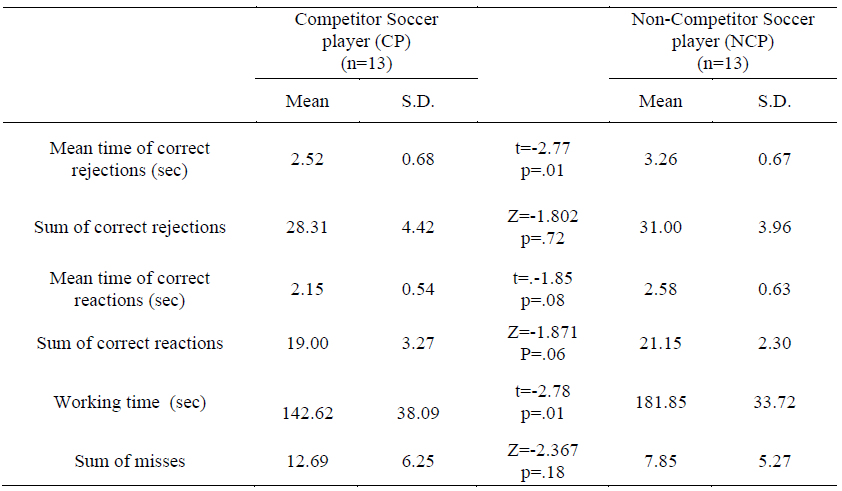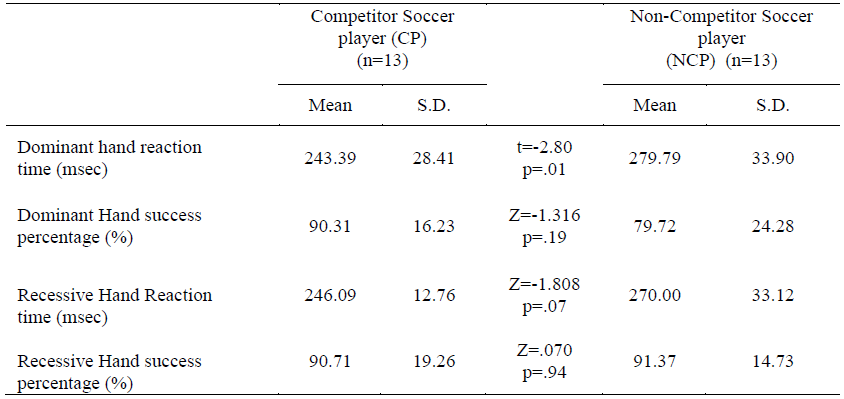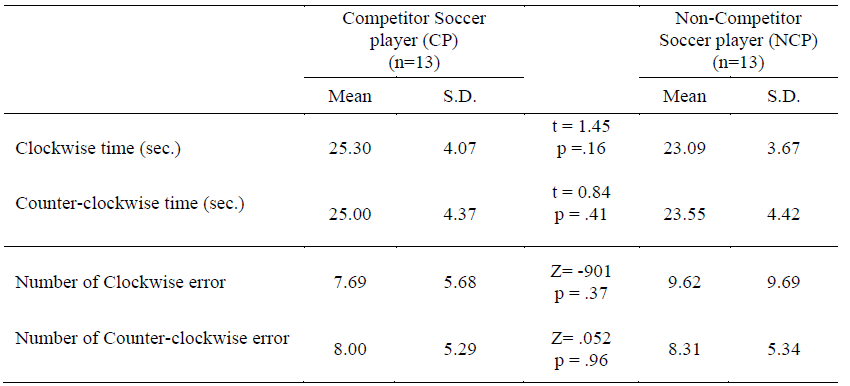Abstract
The purpose of the present study was to evaluate the skills that will positively influence child
Keywords: “Young,” “soccer,” “attention,” “eye-hand coordination,” “reaction time”
Introduction
Attention, concentration, eye-hand coordination and reaction time are considered to be integral
basics of sports. The attention-grabbing physical and mental characteristics of human nature have been
included in the sports literature as general information, particularly in research articles that analyse how
much various activities done for a certain period of time affect them (Bańkosz, Nawara, & Ociepa, 2013,
Boot et all. 2008 Crawford, Medendrop & Marotta, 2004, Ederman, Murray, Mayer &Sagendorf, 2004,
Göral, Saygın & İrez, 2012).
Attention is the conscious or unconscious focus of perception on a certain object, action, activity,
situation, event or phenomenon, which determines the quality of decision-making and performance
(Schefke, & Gronek, 2010). Attention and concentration are among the important factors for athletic
performance in sports. Some changes are observed in people who focus their psychological and physical
energy on a single point. Sense organs focus on the people, objects or events in question so as not to miss
any details. In addition to the sense organs, athletes’ bodies also adjust (Özerkan, 2004).
Visual motor coordination is defined as receiving visual stimuli and generating appropriate motor
answers with mind-body coordination. This is known as eye-hand coordination. The visual-motor
coordination skills include: walking, running, jumping, climbing, cooking, dressing, undressing,
buttoning, washing hands and face, brushing teeth, cycling, driving, using computer, coloring, reading-
writing and using scissors. In addition, they play a significant role in self-sufficiency and successful
school and social life. The development of visual motor coordination in children starts with directing
towards various objects within their visual field and using their body and hands (Ercan &Aral, 2011).
Athletes should have high physiological and motor performance for success in sports. Particularly
for football players, it will provide an advantage if the events are arranged in advance and they make a
move before their opponents. One of the parameters that will allow them to gain advantage is their
reaction time. Reaction time refers to the time that passes from between receiving a sudden and non-
prefigured signal to responding to this signal. The stimuli can be auditory, visual or tactile (Göral, Saygın
& İrez, 2012).
This study evaluates the skills considered to have positive effects on both child development and
sportive performance such as attention, eye-hand coordination and reaction time of young competitor
(CP) and non-competitor (NCP) football players..
Problem Statement
Examination of skills, such as attention, eye-hand coordination and reaction time in competitors
and non-competitor soccer players will provide information for coaches to plan and organize training
program..
Research Questions
Is there any difference between competitor and non-competitor soccer players in attention, eye-
hand coordination and reaction time?.
Purpose of the Study
The purpose of present study was to evaluate the skills that will positively influence child
development, such as attention, eye-hand coordination and reaction time, among young competitors and
non-competitor soccer players..
Research Methods
Participants
The study was conducted with 26 ten- to twelve-year-old football players, 13 non-competitor
football players training twice a week at Antalyaspor Lara Football School and 13 competitor football
players playing for Laraspor Football Club. The licensed football players who competed for Lara Sports
Club were included in the competitor group, and the non-licensed players who attended the football
school, but did not compete, were included in the non-competitor group.
Methods
The assessments were made at the Laraspor Football Club. The attention, eye-hand coordination
and reaction time tests were administered to both groups in the meeting area in the training ground.
Cognitrone Attention-Concentration Test (COG); Cognitrone is a general ability test that assess
attention and concentration among the Vienna test system batteries. It requires noticing the similarities
between constantly changing figures within the tests’ integrity and reacting rapidly and correctly.
Participants are asked to compare the figures on the screen and make a decision about their similarities.
Four different figures are displayed on the upper part of the screen, and one figure is displayed on the
lower part. Participants are asked to press the green button on the panel with their right hands when they
understand that the figure on the lower part matches with the figure on the upper part; or otherwise, to
press the red button. The total duration of the test is 15 to 20 minutes (Psikotek Consulting, 2012).
Eye-Hand Coordination Assessment; Eye-hand coordination was assessed using the Two Arm
Coordination Test. This test was done using the Lafayette Instrument Two-Arm Coordination Tester
Model 32532A and the Lafayette Instrument Silent Impulse Counter Model 58024C (Lafayette, 2004).
This test assesses the participants’ two eye-hand coordination by tracking the star on the test device using
a metal pointer with both hands clockwise and counter-clockwise. Whenever the participants deviate from
the trace they should track, the stimulant counter records it (Green,1996).
Reaction Time Suite; Reaction time was assessed using the Reaction Time Suite together with the
ProComp Infinity device and Biograph Infinity software. Visual and auditory reaction times were
assessed using computers. In single assessment, the computer sends a single stimulant (visual or
auditory), and the participants react to this stimulant by pressing the button as quickly as they can. If the
participants do not answer a stimulant or give their answer in the wrong order, this counts as an error
(Thought Technology, 2012).
The statistical analysis of the data was done using SPSS and Excel (Analyses Tool Pack) software.
First, the data were subjected to descriptive statistics. The normal distribution criteria were determined
using the Shapiro-Wilk test since the sample size was under 50. The independent samples t test was used
for normally distributed variables, and the Mann-Whitney U test was used for non-normally distributed
variables during the comparison of competitor and non-competitor groups. Results are shown as mean ±
SD, and for all comparisons p <.05 was considered significant.
Findings
A total of 26 football players (13 competitors and 13 non-competitors) from the Laraspor Football
Club and Antalyaspor Lara Football Academia voluntarily participated in the study with their families’
permission.
The Cognitrone Test, a computer-based attention test, as well as the Reaction time Test through
the Reaction Time Suite and Lafayette Two Arm Coordination Test were administered to the participants.
The competitor group was significantly older than the non-competitor group (p<0.05).

No significant difference was found between CP and NCP sum of and mean time of correct
reactions, the sum of correct rejections and sum of misses (p>0.05). A statistically significant difference
was found between the competitor and non-competitor groups in terms of the mean time of correct
rejections (CP=2.52±0.68 sec, NCP=3.26±0.67 sec) (p<0.05).
The competitor group showed significantly shorter mean times of correct rejections than the non-
competitor group. A statistically significant difference was found between the groups in terms of the
working time (total processing time) (t=-2,78, p=.01). The competitor group obtained a better mean score
on the Cognitrone Test than the non-competitor group in terms of the working time (CP=142.62±38.09
sec, NCP=181.85±33.72 sec).
The reaction time of the competitor and non-competitor groups were assessed using the ProComp
Infinity device and Biograph Infinity software, as well as the Reaction Time Suite. Table 02. shows the
reaction time results of the competitor and non-competitor football players.

No statistically significant difference was found between the competitor and non-competitor
groups for recessive hand reaction time (Z=1.808, p=0.07), recessive success rate (Z=0.070, p=0.94) and
dominant success rate (Z=1.808, p=0.071) (p>0.05). The two groups obtained similar values in these
variables. The dominant hand reaction time of the competitor group (243.39±28.41 msec) was statistically
significantly lower than that of the non-competitor group (279.79±33.90 msec) [t=2.80, p=0.01]. The
dominant hand success rate was also found to be statistically significantly higher in the competitor group
(90.31%) than in the non-competitor group (79.72%). No statistically significant difference was found
between the recessive hand reaction times of the groups [Z=1.808, p=0.071] (p>0.05). The competitor
group obtained better scores in dominant reaction time than the non-competitor group.
The eye-hand coordination of the participants was assessed using the Lafayette Instrument Two-
Arm Coordination Tester Model 32532A.

Conclusion
Attention, coordination and reaction time, parts human nature, are cognitive and mental processes
used in every sphere of life. These characteristics are complex in terms of their process and results in both
cognitive and behavioural aspects. Success in physical and mental terms is needed in every kind of sports.
Sports include movement and activity, and therefore is directly related to attention, coordination and
reaction time, the subjects of this study. In addition, ability in these factors will possibly have positive
effects on the quality of physical appropriateness factors as well as psychological factors.
The football players’ attention variables were assessed using the Cognitrone Test, and a
statistically significant difference was found between the two groups for only the mean time of correct
rejections and working time. The competitor football players had better decision-making times than the
non-competitor football players in the attention test.
The results of competitor and non-competitor football players in recessive hand reaction times and
dominant and recessive hand success percentage were similar, and the differences between the groups
were not statistically significant. A statistically significant difference was found between the dominant
hand reaction times of the two groups. The competitor football players had a better reaction time.
No study was found in the literature that compares competitor and non-competitor football players
in this age group in terms of these variables. This section refers to different studies in the literature.
Bayar and Koruç (1992) assessed the reaction time and eye-hand coordination of the students in
summer sports school at the 19 Mayıs Sports Site who were born between 1977 and 1982 and observed
that female students born in 1982 had a shorter reaction time than male students at the same age.
However, males’ reaction times shortened and females’ reaction times lengthened as they got older
(Boyar, 2013).
A study that aimed to determine the light (visual) reaction times of male football players aged
between 9 and 14 found that a football training program provided for 16 weeks positively affected
children’s light (visual) reaction time (Boyar, 2013).
Marancı (1999) conducted a study with amateur football players and found that the reaction times
to a visual stimulant were 470 msec for goalkeepers, 530 msec for defensive players, 510 msec for
midfield players and 490 msec for strikers. Their reaction times to an auditory stimulant were 397 msec
for goalkeepers, 490 msec for defensive players, 430 msec for midfield players and 420 msec for strikers
(Marancı, 1999).
No significant difference was found between the competitor and non-competitor football players
for the clockwise time, counter-clockwise time, number of clockwise and counter-clockwise error
variables. The football players in both groups obtained very similar results in eye-hand coordination.
In conclusion, this study found that the attention and the dominant hand reaction time were
different between competitor and non-competitor trained male football players aged between 10 and 12,
and that being a competitor or non-competitor did not affect their eye-hand coordination. It can be
concluded that similar trainings of the competitor and non-competitor football players led these groups to
show no difference.
Attention, reaction time and coordination are important variables that create the difference
between successful and unsuccessful players in football. Therefore, trainers and physical educators should
use the attention, coordination and reaction time exercises starting at an early age to stimulate these
athletic skill
References
- Bańkosz, Z., Nawara, H. & Ociepa, M. (2013). Assessment of simple reaction time in badminton players.
- Trends in Sport Sciences, 1(20): 54-61.
- Bayar, P., & Koruç, Z. (1992). Preliminary study for determination of Turkish norms of reaction time and hand-eye coordination of two vehicles (Reaksiyon zamanı ve el-göz koordinasyonu ölçer iki aracın Türkiye normlarının saptanmasına yönelik ön çalışma.) Sports Sciences National Symposium Proceedings 136-143, Ankara.
- Boot, W. R., Kramer, A. F., Simons, D. J., Fabiani, M., & Gratton,G.(2008). The effects of video game playing on attention, memory, and executive control. Acta Psychologica 129, 387–398 Boyar, H. (2013). Determination of the visual reaction times of 9-14 age group soccer players (Futbol branşına katılan 9–14 yaş grubu erkek Çocuklarının ışık reaksiyon zamanlarının belirlenmesi). Selçuk University, Health Science Institution, Master Thesis.
- Crawford, J., Medendorp, W., Marotta, J.(2004). Spatial Transformations for Eye–Hand Coordination. J., Neurophysiol 92: 10–19, 2004; 10.1152/jn.00117.2004 Edermann, B. E.,Murray,S. R., Mayer, J. M. & Sagendorf,K.(2004). Influence Of Cup Stackıng On Hand-Eye Coordınatıon And Reactıon Tıme Of Second-Grade Students. Perceptual and Motor Skills, 98, 409-411, Ercan G, Aral N. (2011). An Investigation of the Effect of Visual Perception Education on the Development of Visual-Motor Coordination of Children's Kindergarten. (Anasınıfı Çocuklarının Görsel-Motor Koordinasyon Gelişimine Görsel Algı Eğitiminin Etkisinin İncelenmesi’). Journal of Turkish Education Sciences. Summer, 9(3), 443-466 Green, H, J. (1996). Mechanisms of muscle fatigue in intense exercise. Journal of Sports Sciences, 15, 247-256 Göral K, Saygın Ö, İrez G. (2012). Examination of Visual and Auditory Reaction Times by Professional Soccer Players (Profesyonel Futbolcuların Oynadıkları Mevkilere Göre Görsel ve İşitsel Reaksiyon Sürelerinin İncelenmesi). Journal of Physical Education and Sport Science Selçuk University, 14 (1): 5-11.
- Lafayette, (2004) Two Arm Coordination Test User Manual Lafayette Instrument Company, Inc. Lafayette IN 47903 USA.
- Marancı B. (1999). Comparison of the motor characteristics, reaction times and body fat percentages of football players and other players in Ankara 1.amateur league (Ankara 1.amatör liginde mücadele eden futbol kalecileri ve diğer mevkilerde bulunan oyuncuların motorik özellikleri, reaksiyon zamanları ve vücut yağ yüzdelerinin karşılaştırılması), Ankara University, Health Science Institution, Master Thesis.
- Özerkan N. K. (2004) Introduction to Sports Psychology, Basic Concepts (Spor Psikolojisine Giriş, Temel Kavramlar), 2004, Nobel Publications.
- Psikotek Consulting (2012), Cognitrone Test Structure and Sample Reports Schefke, T., Gronek, P. (2010). Improving Attentional Processes in Sport: Defining Attention, Attentional Skills and Attention Types. Studies in Physical Culture and Tourism, 17(4): 295-299.
- Thought Technology (2012) Reaction Time Suit Manual (Thought Technology Ltd. 2180 Belgrave Avenue, Montreal, QC H4A 2L8 Canada
Copyright information

This work is licensed under a Creative Commons Attribution-NonCommercial-NoDerivatives 4.0 International License.
About this article
Publication Date
12 June 2017
Article Doi
eBook ISBN
978-1-80296-023-5
Publisher
Future Academy
Volume
24
Print ISBN (optional)
-
Edition Number
1st Edition
Pages
1-91
Subjects
Sports, sport science, physical education
Cite this article as:
Aktop, A., Kuzu, O., & Çetin, E. (2017). Analysis Of Attention, Eye-Hand Coordination And Reaction Time Of Young Soccer Players. In E. Lupu, G. Niculescu, & E. Sabău (Eds.), Sport, Education & Psychology - icSEP 2017, vol 24. European Proceedings of Social and Behavioural Sciences (pp. 13-19). Future Academy. https://doi.org/10.15405/epsbs.2017.06.2

